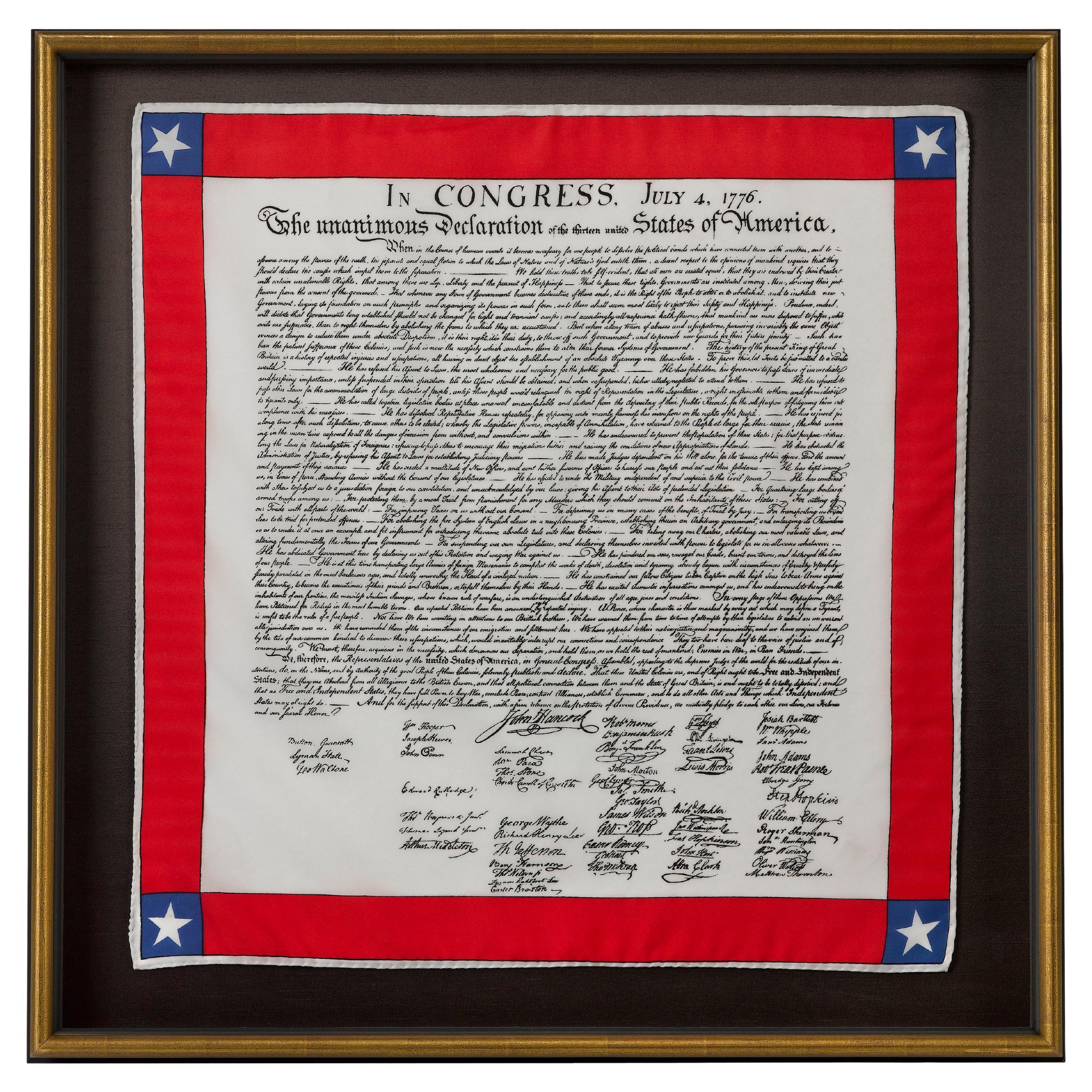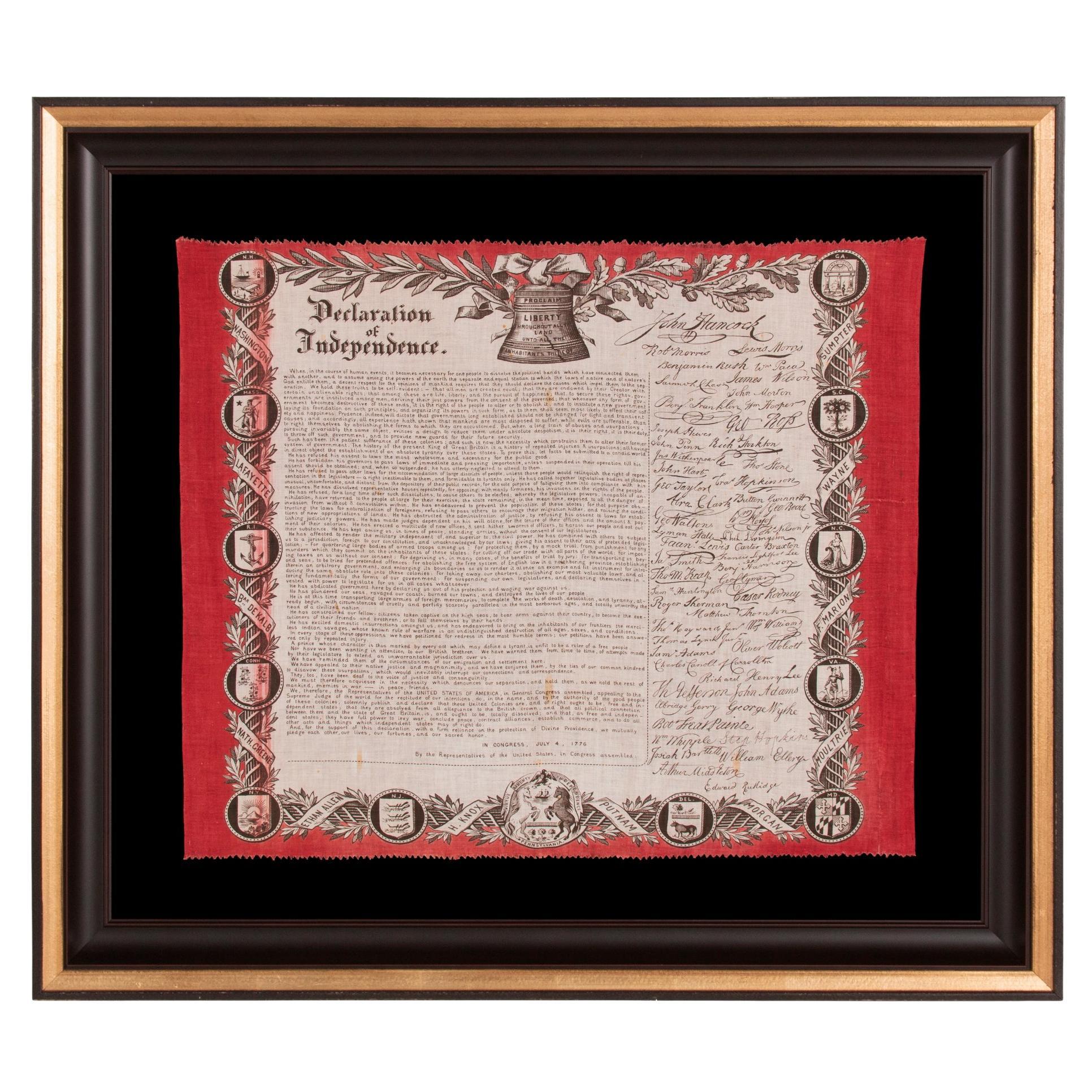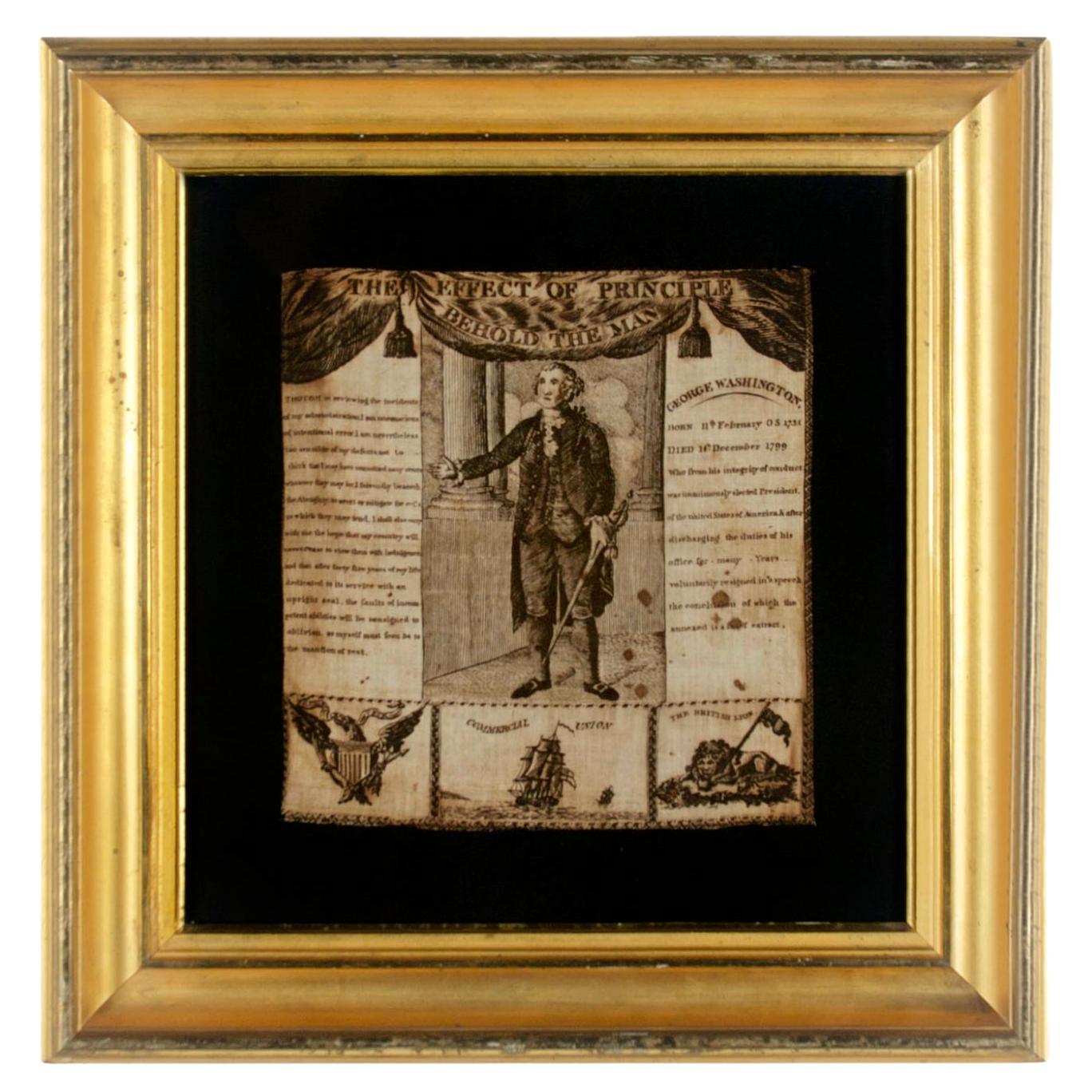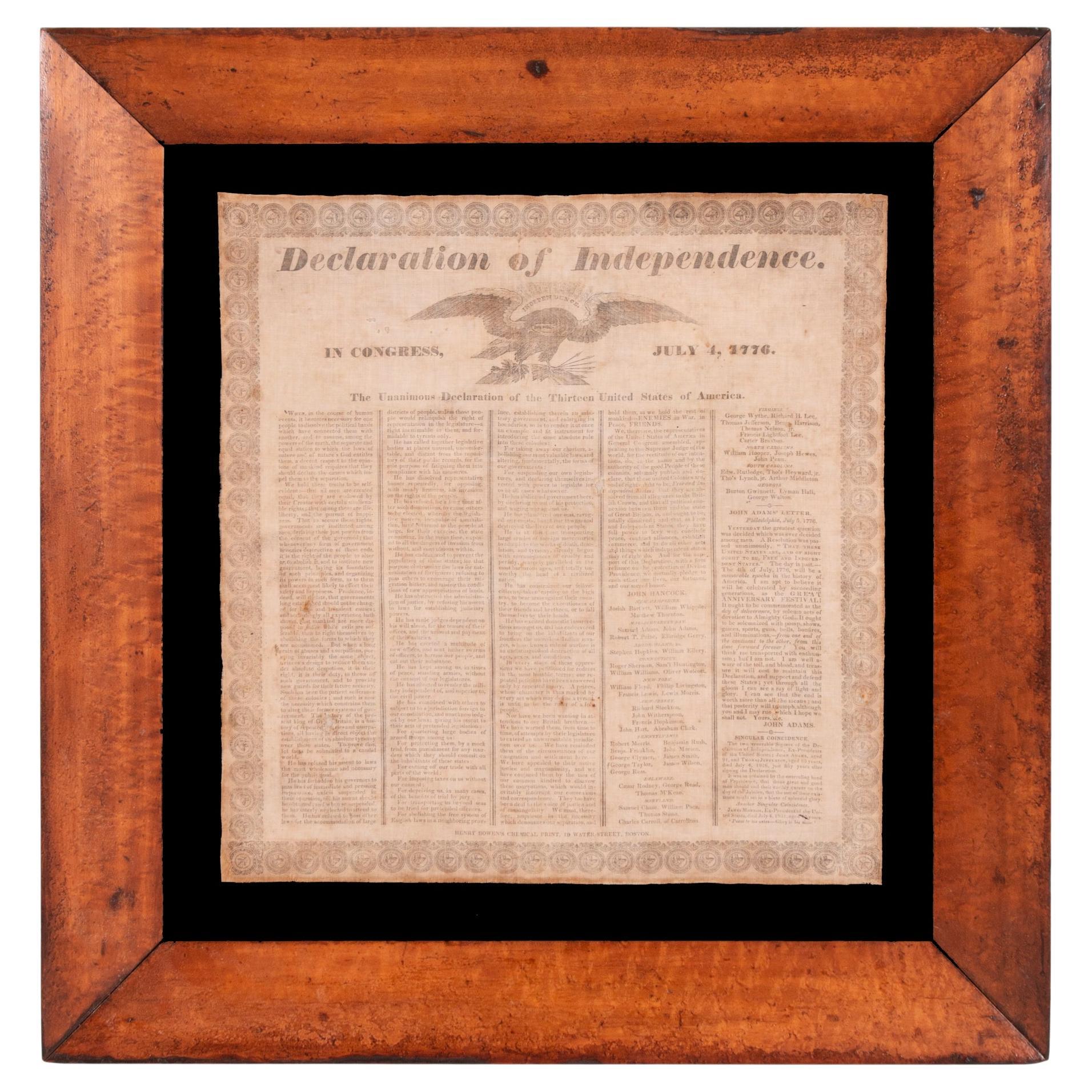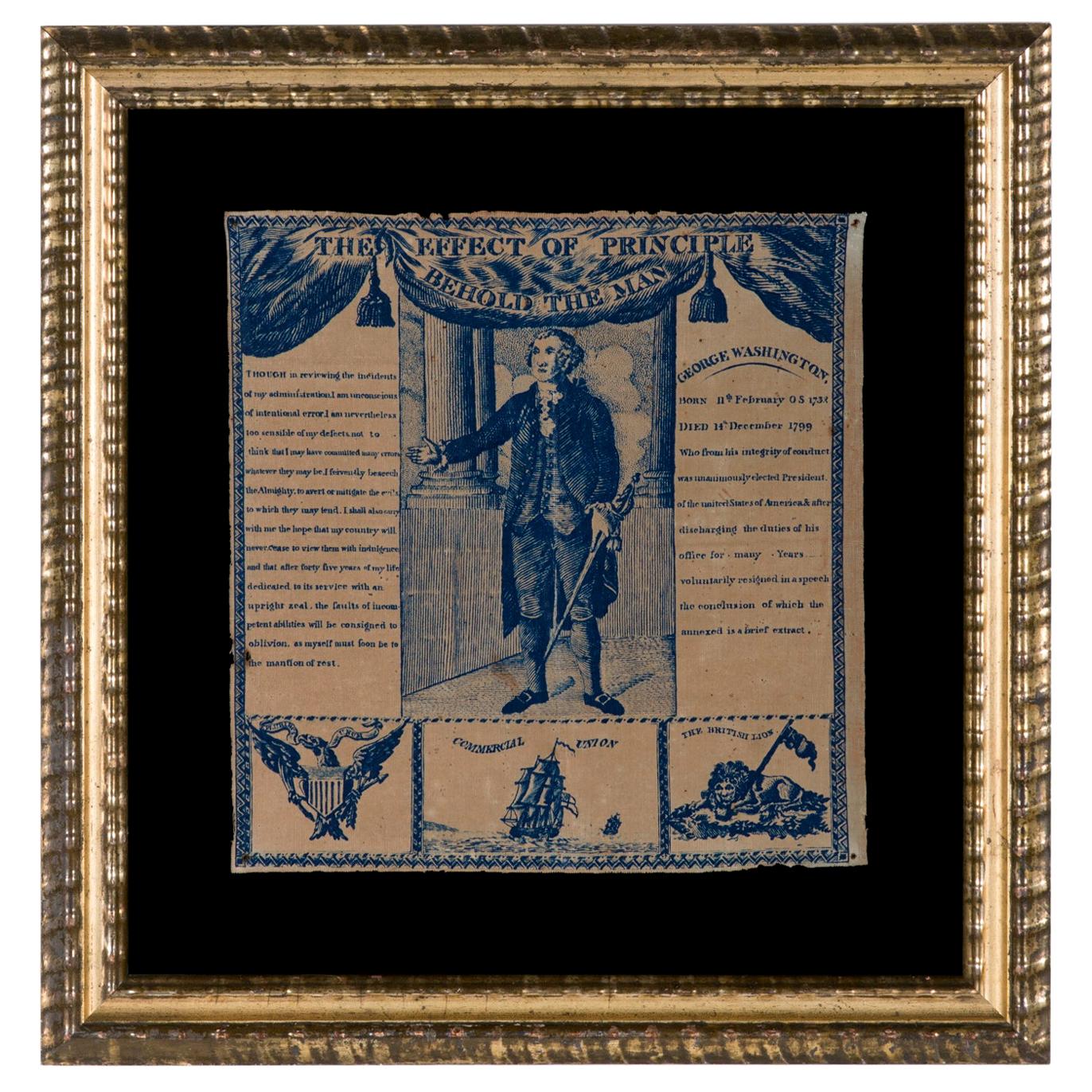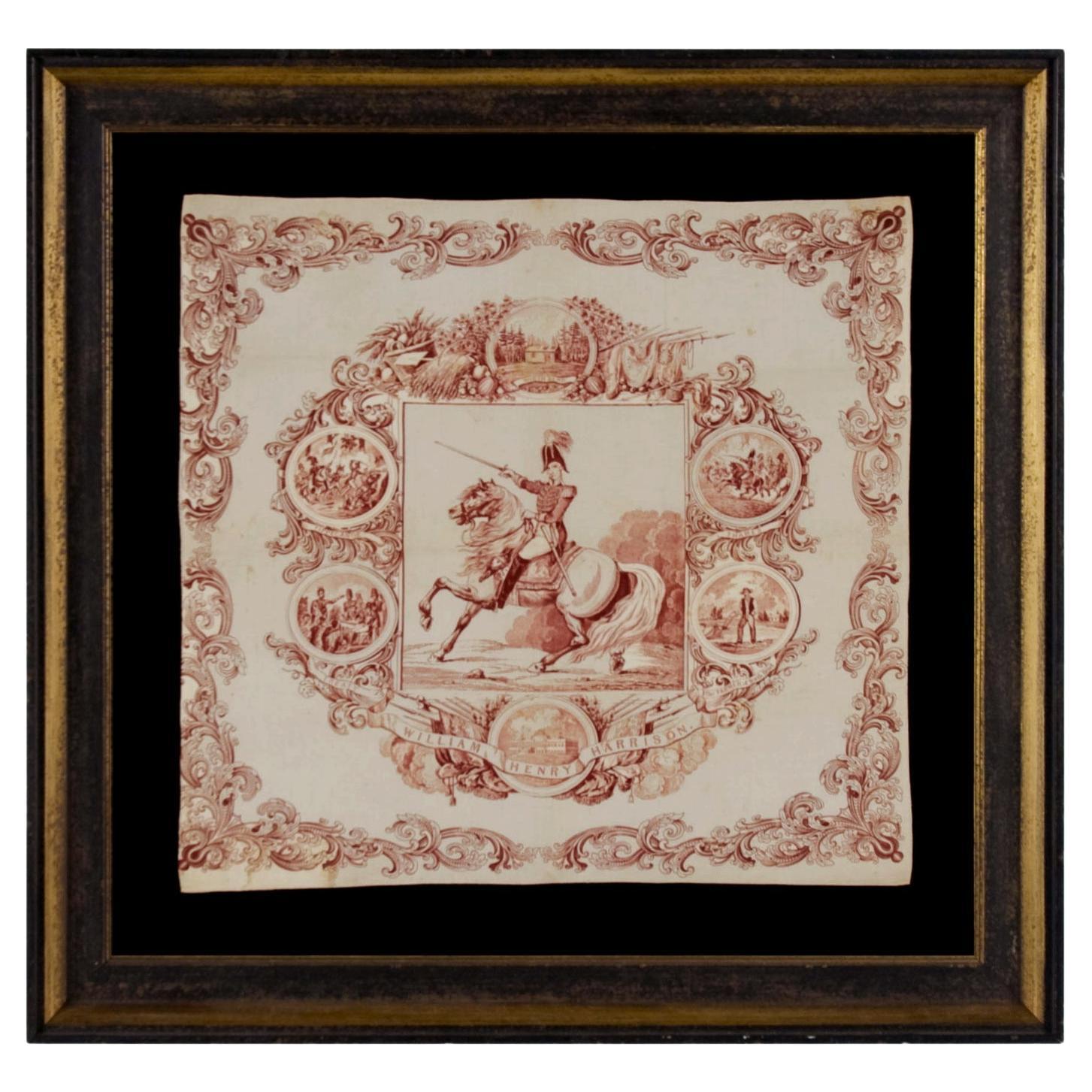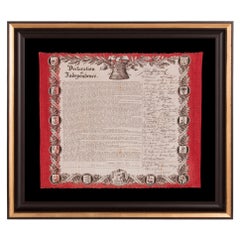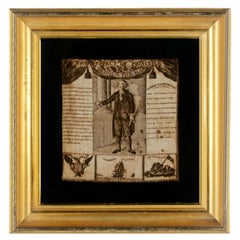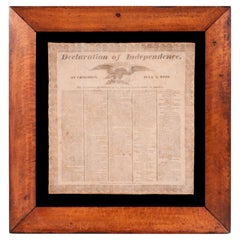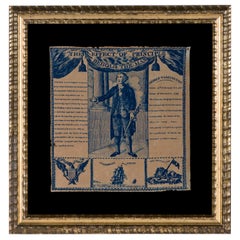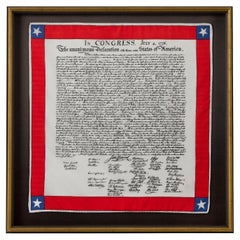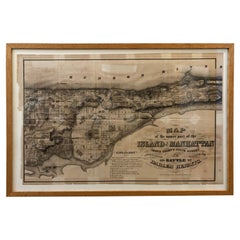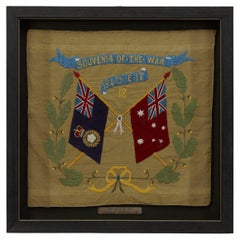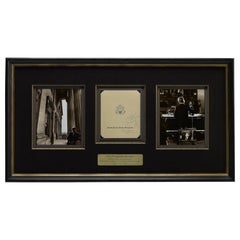Items Similar to Large Scale Printed Kerchief of the Signing of the Declaration of Independence
Want more images or videos?
Request additional images or videos from the seller
1 of 8
Large Scale Printed Kerchief of the Signing of the Declaration of Independence
About the Item
Rare, large scale Kerchief with a beautifully engraved image of John Trumbull’s “Declaration of Independence,” likely made in 1826 for our nations Semi centennial (50th anniversary); the only example I have ever seen of this exceptionally rare textile that retains its original, red coloration.
Printed on cotton, this extraordinarily detailed, large format kerchief pays respect to the Declaration of Independence through its depiction of the famous oil on canvas painting by John Trumbull, George Washington’s aide-de-camp and accomplished painter of historical views. Above the image is the following text: “Declaration of Independence of the United States Of America 4th July 1776.” Below is an accompanying legend that identifies each person by name in a generic script.
Many have mistakenly identified Trumbull’s painting as “The Signing of the Declaration of Independence.” Trumbull himself called it “The Declaration of Independence, July 4th, 1776.” What it actually portrays, however, is the presentation of the original draft of the document to the Second Continental Congress, which took place six days prior, on June 28th. This is why the illustrated men represent only 42 of the 56 who would eventually sign, and 5 others who did not sign at all.
The draft was presented by “The Committee of Five,” prominently featured to the right of center. Led by Thomas Jefferson (Virginia), this group included John Adams (Massachusetts), Benjamin Franklin (Pennsylvania), Robert Livingston (New York), and Roger Sherman (Connecticut). They stand in Independence Hall before the desk of John Hancock, president of the governing body.
It is of interest to note that Congress revised the draft on July 2nd, and publicly declared American independence that day from Britain. The Declaration was formally adopted on July 4th, with 49 of delegates present in Philadelphia and 7 absent. The New York delegation had been specifically instructed not to sign. The physical document needed to be sent to an engraver and printed. 42 delegates signed about a month later, on August 2nd, 1776. The remaining 14 signed after. 7 of these were actually new members of Congress, added after July 4th. 7 of the men present on July 4th never signed at all.
Trumbull painted many of these men from life. He also visited Independence Hall, in order to get the elements of the interior correct. Trumbull was known for his accuracy of detail, so of notable interest is the rather ironic presence of crossed British flags on the wall in the background. His original painting now hangs in the Yale University Art Gallery, our nation’s first university museum, which Trumbull both designed and furnished, with 88 of his personal works, sold to Yale in 1831 in exchange for a $1,000 annuity. Most of the painting’s fame comes from the other copy of the work, a 12 x 18 version that was commissioned from Trumbull by Congress in 1817. This was installed in the United States Capitol Rotunda in 1826, the year of America’s 50th anniversary of independence, where it remains today.
An example of a closely related bandanna is documented as item 418 in “Threads of History” by Herbert Ridgeway Collins (Smithsonian Press, 1979), p. 200. Collins formerly served as the Smithsonian's curator of political history and his text is considered the definitive reference on American political textiles. He dates the illustrated kerchief to 1876, under the surmise that it was made in conjunction with the 100-year anniversary of our nation’s independence. This date is certainly incorrect. The very large format closely resembles those made between 1800 and the 1850’s. The known color variations and dyes provide the same confirmation. The hemming of the top and bottom provides additional clues. Hand-sewn with exceptional precision, it differs from most kerchiefs made in 1876 and later, the edges of which, without selvage, are more likely to be bound by treadle machine. Since none of these traits point to the latter 19th century, the kerchief was not made to celebrate 100 years of American Independence in 1876, but more likely 50 years of independence, in 1826 (our nation's semicentennial or quinquagenary). This would coincide with the hanging of Trumbull’s painting in the capitol rotunda, and would thus better explain not only its size, coloration, and construction, but also its purpose.
A seemingly reasonable alternative is that it was produced for our nation’s 75th anniversary, in 1851, but practically nothing seems to have been made for this event, in terms of patriotic and political cloth. Out of the 1,500 items depicted by Collins, for example, nothing is attributed to that exact year. Further, after more than 32 years in the antiques business, and about 24 years of aggressive buying of flags specifically, plus exhaustive research, I have not encountered anything in a commemorative, patriotic textile, flag, or banner, that I can positively date to any related event in precisely that year. Though I have occasionally asserted the possibility of 1851 manufacture, that year is notedly void of representation.
The Collins-documented kerchief was certainly produced by the same maker, and I suspect that the two variants to have been printed together, maybe even on the same bolt of fabric. The Collins version utilizes the same view of Independence Hall, except larger, with an expansive legend that identifies each man by way of a number and crude portrait, followed by facsimiles of their actual signatures.
Surviving examples of these kerchiefs are extremely rare. The style in question here, thus far undocumented in any text on the subject, is even more rare than the variety illustrated by Collins. I have discovered both versions exist in two colors. Until now, I thought these were blue and sepia, which faded to brown. Though I wondered if the brown may have actually been red originally, I could find no definite proof until I discovered this example. This is the only one I have ever seen that retains the original, oxblood red hue.
It is of interest to note that the kerchief illustrated by Collins actually differs slightly from all of the others I know to exist. Blue in color along the border, the word “Independence” is misspelled as “Independance”.
On the original painting, many have noted that Jefferson’s foot, which is pointed at a somewhat odd angle, is purposely stepping on that of Adams. The two men were political enemies, so it is supposed that this was done on purpose. Close inspection, however, revealed that their shoes were merely close to one-another. Trumbull widened the distance in the Rotunda copy and a clear separation of their feet can be seen in the reproduction of the image on the kerchiefs. A curious historical fact is that Jefferson and Adams both left this world on July 4th, 2026, 50 years to the day after the document was formally adopted.
Mounting: The flag was mounted and framed within our own conservation department, which is led by expert trained staff. We take great care in the mounting and preservation of flags and have framed thousands of examples.
The background is 100% hemp fabric or a hemp and cotton blend, with a twill weave. The mount was then placed in a black-painted, hand-gilded and distressed Italian molding. The glazing is U.V. protective acrylic (Plexiglas). Feel free to contact us for more details.
Condition: Exceptional among known examples, with but minor foxing and staining. As noted above, this is presently the only known example I know of to retain its original, red coloration.
- Dimensions:Height: 42.25 in (107.32 cm)Width: 44.25 in (112.4 cm)Depth: 2.5 in (6.35 cm)
- Materials and Techniques:
- Place of Origin:
- Period:
- Date of Manufacture:1826-1851
- Condition:See Item Description.
- Seller Location:York County, PA
- Reference Number:Seller: ker-2391stDibs: LU849731148792
About the Seller
5.0
Recognized Seller
These prestigious sellers are industry leaders and represent the highest echelon for item quality and design.
Established in 1991
1stDibs seller since 2008
69 sales on 1stDibs
Typical response time: 13 hours
- ShippingRetrieving quote...Shipping from: York County, PA
- Return Policy
Authenticity Guarantee
In the unlikely event there’s an issue with an item’s authenticity, contact us within 1 year for a full refund. DetailsMoney-Back Guarantee
If your item is not as described, is damaged in transit, or does not arrive, contact us within 7 days for a full refund. Details24-Hour Cancellation
You have a 24-hour grace period in which to reconsider your purchase, with no questions asked.Vetted Professional Sellers
Our world-class sellers must adhere to strict standards for service and quality, maintaining the integrity of our listings.Price-Match Guarantee
If you find that a seller listed the same item for a lower price elsewhere, we’ll match it.Trusted Global Delivery
Our best-in-class carrier network provides specialized shipping options worldwide, including custom delivery.More From This Seller
View AllThe Declaration of Independence, Printed on Cotton, ca 1876
Located in York County, PA
PRINTED COTTON KERCHIEF GLORIFYING THE DECLARATION OF INDEPENDENCE, WITH TEXT AND REPRODUCED SIGNATURES, MADE FOR THE 1876 CENTENNIAL INTERNATIONAL EXPOSITION IN PHILADELPHIA
Printed on cotton, this beautiful kerchief pays homage to the Declaration of Independence, through the reproduction of its text and 56 signatures, surrounded by a fanciful border. The latter contains the 13 state seals, which are dispersed around the perimeter in small medallion images. Note how Pennsylvania is highlighted among them, larger and in the bottom center, both because it served as the meeting place of the Second Continental Congress, and played host to the 1876 Centennial International Exposition, the six-month long World’s Fair event that was held in honor of our nation’s 100-year anniversary of independence.
The names of twelve Revolutionary War generals are spread out between each crest, on each forward-facing turn of a scroll, that wraps around the pillar and leaf border on the right, left, and bottom. These include Washington, Lafayette, Johann de Kalb, Nathiel Greene, Ethan Allen, Henry Knox, Israel Putnam, Daniel Morgan, William Moultrie, Francis Marion...
Category
Antique Late 19th Century American Political and Patriotic Memorabilia
Materials
Cotton
Price Upon Request
Printed Linen Kerchief of George Washington, ca 1806, Germantown, PA
Located in York County, PA
Extraordinarily early (1806) printed linen kerchief glorifying George Washington, Germantown print works, Germantown, Pennsylvania
Printed in sepia ink on coarse, white linen, this patriotic kerchief shows a standing portrait of George Washington, above which is a swag valance and the words “The Effect of Principle, Behold the Man”. The portrait is based on a mezzotint after Gilbert Stuart’s very famous painting of Washington in his later years. Stuart painted it in oil on canvas for a wealthy merchant by the name of William Constable, who commissioned the work for Alexander Hamilton.
The kerchief is interesting because it is both American-made and documented. This is exceptionally unusual for any printed textile of the 19th century or prior and the earlier the time period the more unlikely an object is to be identified. This kerchief and a companion piece entitled “The Love of Truth Mark the Boy” (also glorifying Washington through the fabled story of the cherry tree), were made ca 1806 by Germantown Print Works in Germantown, Pennsylvania.
To the left of Washington's image is a portion of his infamous farewell address to his troops at the end of the Revolutionary War. To the right is a short excerpt from his eulogy. Below these are three images. In the center is a square-rigged tall ship with “Commercial Union” above it, flanked by the American eagle on the left and the British lion...
Category
Antique Early 19th Century American Political and Patriotic Memorabilia
Materials
Linen
Declaration of Independence on Cloth, Printed in Boston 1832
Located in York County, PA
COPY OF THE DECLARATION OF INDEPENDENCE ON CLOTH, PRINTED IN BOSTON IN 1832 TO MEMORIALIZE THE PASSING OF THE LAST SURVIVING SIGNER, CHARLES CARROLL OF MARYLAND, IN THE YEAR THAT COI...
Category
Antique 1830s American Political and Patriotic Memorabilia
Materials
Cotton
Price Upon Request
1806 Printed Linen Kerchief Glorifying George Washington, Germantown, Penn
Located in York County, PA
EXTRAORDINARILY EARLY (1806) PRINTED LINEN KERCHIEF GLORIFYING GEORGE WASHINGTON, PRINT WORKS, GERMANTOWN, PENNSYLVANIA
Printed in blue ink on coarse, white linen, this patriotic kerchief shows a standing portrait of George Washington, above which is a swag valance and the words “The Effect of Principle, Behold the Man”. The portrait is based on a mezzotint after Gilbert Stuart’s very famous painting of Washington in his later years, most often referred to as the Landsdowne portrait. Stuart painted three versions of it in oil on canvas, one of which was completed in 1796 for a wealthy merchant by the name of William Constable, who commissioned the work for Alexander Hamilton.
The kerchief is interesting because it is both American-made and documented. This is exceptionally unusual for any printed textile of the 19th century or prior and the earlier the time period the more unlikely an object is to be identified. This kerchief and a companion piece entitled “The Love of Truth Mark the Boy” (also glorifying Washington, through the fabled story of the cherry tree), were made circa 1806 by Germantown Print Works in Germantown, Pennsylvania.
To the left of Washington's image is a portion of his infamous farewell address to his troops at the end of the Revolutionary War. To the right is a short excerpt from his eulogy. Below these are three images. In the center is a square-rigged tall ship with “Commercial Union” above it, flanked by the American eagle on the left and the British lion on the right. It is reasonable to assume that the textile may have been produced in demonstration of the maker's desire, and/or that of others, to advance trade with England. Commercial printers were very influential in early America, as they possessed the means by which to disseminate information.
This kerchief and its companion piece are documented in Threads of History, Americana Recorded on Cloth, 1775 - the Present, by Herbert Ridgeway Collins (1979, Smithsonian Press), p. 63, items 38 & 39.* The two pieces pictured are in the collection of Cornell University, but the Collins text also cites an uncut pair to be present in the collection of the Western Reserve Historical Society, Cleveland, OH. The name "Germantown Print Works" is printed on the Western Reserve examples. Another example of the textile in question is documented in "Running for President, The Candidates and Their Images, 1789-1896" by Schlesinger, Israel, and Frendt, (1994, Simon & Schuster), p. 15.
I have seen three different color variations of this textile, including sepia, mulberry red, and blue. This particular example has a hand-sewn binding along the top, lower, and left edges.
Mounting: The textile was mounted and framed within our own conservation department, which is led by expert staff. We take great care in the mounting and preservation of flags and have framed thousands of examples.
The gilded molding has a rippled profile and dates to the period between 1825 and 1850.The background is 100% cotton twill, black in color. The glazing is U.V. protective plexiglass. Feel free to contact us for more details.
Condition: There is an all-over golden oxidation of the white fabric and there is very minor staining. There are tiny tack holes in each corner and there are minor nicks around the perimeter.
* Collins relates that Germantown Printworks was operated by the Hewsons. In doing so he cites one of Worthington Chauncey Ford's books on George Washington, but it isn't clear which one (there are many) and no page numbers are given. John Hewson was an Englishman who came to America and opened his printing business on the advice of Benjamin Franklin. He was one of the first “calico printers” and is the earliest documented to have advertised printed kerchiefs. His ads for bandanas appear as early as June 20th, 1774. He is suspected of having produced the very first American kerchief that pictured an American president, which is documented in Collins as item 1 on page 48. Linda Eaton, curator at Winterthur, in 2012, is currently doing in depth research on the three printers of fabrics that were operating in Germantown in early America. She discovered that the owner and/or operator of Germantown Print Works, while not currently known, was not John Hewson. This information is not yet published. She also noted that Winterthur possessed examples of the two George Washington textiles...
Category
Antique Early 1800s American Political and Patriotic Memorabilia
Materials
Cotton
1840 Campaign Kerchief of William Henry Harrison on Horseback
Located in York County, PA
1840 campaign kerchief featuring an image of William Henry Harrison on horseback in military garb, one of the first known campaign textiles in e...
Category
Antique Mid-19th Century American Political and Patriotic Memorabilia
Materials
Cotton
Price Upon Request
Hand-Painted Patriotic Banner With The Seal of the State of Illinois
Located in York County, PA
HAND-PAINTED PATRIOTIC BANNER WITH THE SEAL OF THE STATE OF ILLINOIS AND GREAT FOLK QUALITIES PROBABLY MADE FOR THE 1868 DEMOCRAT NATIONAL CONVENTION...
Category
Antique 1860s North American Political and Patriotic Memorabilia
Materials
Canvas
Price Upon Request
You May Also Like
Declaration of Independence Printed Scarf
Located in Colorado Springs, CO
Presented is a patriotic silk scarf, celebrating the Declaration of Independence. At center of the silk scarf design is artistic rendering of the Declaration of Independence. The famous text and signatures are printed in black ink on white silk. A border of bright red encloses the text, with a five-pointed white star set against a blue square appearing at each corner. This is a newly made silk scarf, printed to celebrate our Nation's foundational text.
The United States Declaration of Independence...
Category
21st Century and Contemporary American Tapestries
Materials
Silk
1868 Map of the Upper Part of the Island of Manhattan Above 86th Street
By Wm. Rogers Mfg. Co.
Located in San Francisco, CA
This wonderful piece of New York City history is over 150 years old. It depicts 86th street and above. It was lithographed by WC Rogers and company. It was made to show what was the Battle of Harlem during the Revolutionary war...
Category
Antique 1860s American American Colonial Maps
Materials
Paper
Souvenir of the War 1914-15-16-17-18 Banner
Located in Colorado Springs, CO
Presented is a stunning textile banner from the first World War, dating to 1918. The square tan cotton cloth is embroidered with two crossed flags, the ...
Category
Vintage 1910s Australian Political and Patriotic Memorabilia
Materials
Cotton
John F. Kennedy Signed Senate Menu Collage
Located in Colorado Springs, CO
Presented is a John F. Kennedy inscribed and autographed United States Senate Restaurant menu. Kennedy signed the menu on April 10, 1957, when he was a Senator representing the state of Massachusetts...
Category
Vintage 1950s American Historical Memorabilia
Materials
Paper
$8,160 Sale Price
20% Off
Fathers of the Air Service Authentic Signature Collage, circa 1926-1993
Located in Colorado Springs, CO
Presented is a collage celebrating the men who made an early impact on the formation of America’s Air Service. Complete with signatures by Jimmy Doolittle, Tooey Spaatz, Hap Arnold, ...
Category
Late 20th Century American Historical Memorabilia
Materials
Paper
George H. W. Bush Signed and Inscribed 1989 Inaugural Photograph
Located in Colorado Springs, CO
Presented is a wonderful inscribed color photo of the inauguration of George H.W. Bush as the 41st President of the United States held on January 20, 1989. The inauguration marked the commencement of the four-year term of George H. W. Bush as President and Dan Quayle as Vice President. The photograph is signed and inscribed to Ron Wade, who once served as a White House page for President Nixon. Inscription reads, "To Ron Wade/ Sincerely /George Bush" Mr. Wade then scripted a note on the verso of the photo, stating "Signed as President, week of 6-1/-89".
The inauguration of George H. W. Bush as the 41st president of the United States was held at the West Front of the United States Capitol in Washington, D.C. This was the 51st inauguration. Chief Justice William Rehnquist administered the presidential oath of office to Bush and Justice Sandra Day O'Connor administered the vice presidential oath of office to Quayle. Bush was the first sitting vice president to be inaugurated as president (not due to his predecessor's death or resignation) since Martin Van Buren...
Category
Vintage 1980s American Historical Memorabilia
Materials
Paper
Recently Viewed
View AllMore Ways To Browse
United States Congress
Men Of The Day
Signed Memorabilia
The Worlds History And Its Makers
Large Canvas Art Midcentury
Original Signed Document
Antique Hanging Scale
Independence Hall
19th Century Gilded Frames Very Large
Mid Century Drafting
Gilded Hanging Art
Thomas P Hall
Antique British Flag
Italian Men Shoe
Folk Art Connecticut
Antique Shoe Stand
Mid Century Wall Hanging Weave
Distressed Antique Desk
